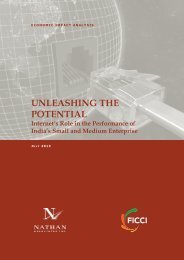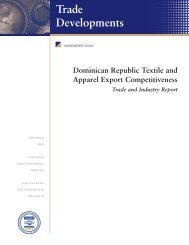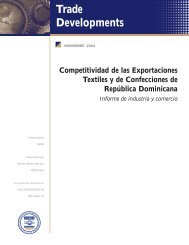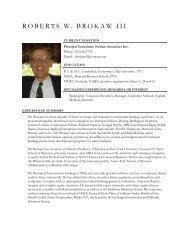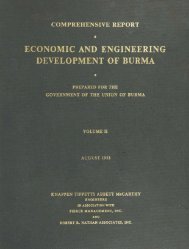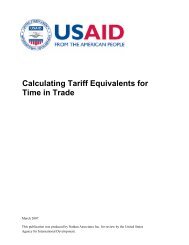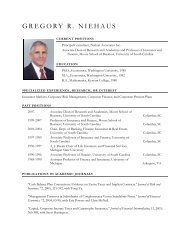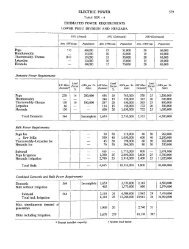Putting it to Work in Developing Countries - Nathan Associates
Putting it to Work in Developing Countries - Nathan Associates
Putting it to Work in Developing Countries - Nathan Associates
You also want an ePaper? Increase the reach of your titles
YUMPU automatically turns print PDFs into web optimized ePapers that Google loves.
CHAPTER 3<br />
1 Data for this chapter are from WIR 2006 except<br />
where noted, and are expressed <strong>in</strong> terms of <strong>to</strong>tal “FDI<br />
<strong>in</strong>flows.” WIR 2006 data have been adjusted <strong>to</strong> conform<br />
<strong>to</strong> the more restrictive def<strong>in</strong><strong>it</strong>ion of develop<strong>in</strong>g<br />
countries expla<strong>in</strong>ed <strong>in</strong> endnote 2.<br />
2 The discussion that follows adopts the World Bank<br />
def<strong>in</strong><strong>it</strong>ion of “develop<strong>in</strong>g countries.” Under <strong>it</strong>, only<br />
low-<strong>in</strong>come and middle-<strong>in</strong>come countries are <strong>in</strong>cluded.<br />
These consist of 150 economies w<strong>it</strong>h per cap<strong>it</strong>a Gross<br />
National Income (GNI) of $10,725 or less <strong>in</strong> 2005.<br />
This elim<strong>in</strong>ates countries classified as “develop<strong>in</strong>g” by<br />
the UNCTAD: S<strong>in</strong>gapore, Hong Kong Ch<strong>in</strong>a, Korea,<br />
Brunei, Taiwan, Cyprus, Kuwa<strong>it</strong>, Qatar, Saudi Arabia,<br />
UAE, Barbados, Bermuda, and Cayman Islands.<br />
Similarly, certa<strong>in</strong> economies considered “developed” by<br />
UNCTAD (e.g., Czech Republic, Es<strong>to</strong>nia, Hungary,<br />
Latvia, L<strong>it</strong>huania, Poland and Slovakia) are classified as<br />
middle <strong>in</strong>come by the World Bank and are <strong>in</strong>cluded<br />
under “develop<strong>in</strong>g” countries <strong>in</strong> this discussion.<br />
3 Data on GDP and trade growth reported <strong>in</strong> GDF<br />
2006, pp. 16–18.<br />
4 This discussion of medium term prospects draws on<br />
Economist Intelligence Un<strong>it</strong>, World Investment Prospects<br />
<strong>to</strong> 2010 Boom or Backlash New York: The Economist<br />
Group (2006).<br />
5 WIR 2006, pp. 36–37, summarizes FDI prospects for<br />
the short-term (2006–2007) and <strong>in</strong>cludes regional and<br />
sec<strong>to</strong>ral views. Various private surveys of bus<strong>in</strong>ess confidence<br />
and <strong>in</strong>vestment sentiment for emerg<strong>in</strong>g markets<br />
are reported there.<br />
6 The Un<strong>it</strong>ed States generated the world’s largest FDI<br />
outflows dur<strong>in</strong>g the 2003–2005 period even though <strong>it</strong>s<br />
outflows for 2005 were $-12.7 billion. These negative<br />
outflows reflected a massive repatriation of earn<strong>in</strong>gs by<br />
U.S. mult<strong>in</strong>ationals from foreign affiliates under the<br />
Homeland Investment Act of 2004. Under certa<strong>in</strong> cond<strong>it</strong>ions<br />
and for a period of one year, mult<strong>in</strong>ationals<br />
could repatriate foreign earn<strong>in</strong>gs at reduced tax rates.<br />
Repatriation of such earn<strong>in</strong>gs is equivalent <strong>to</strong> an offsett<strong>in</strong>g<br />
decl<strong>in</strong>e <strong>in</strong> re<strong>in</strong>vested earn<strong>in</strong>gs of foreign affiliates, a<br />
component of FDI outflows, thus reduc<strong>in</strong>g U.S. outflows.<br />
See WIR 2006, pp. 88–89. The experience<br />
underl<strong>in</strong>es the <strong>in</strong>fluence that home country tax policies<br />
have on the FDI flows, emphasized <strong>in</strong> Chapter 1 (“FDI<br />
by F<strong>in</strong>ancial Component”).<br />
7 See Geng Xiao, “Round-Tripp<strong>in</strong>g Foreign Direct<br />
Investment <strong>in</strong> the People’s Republic of Ch<strong>in</strong>a: Scale<br />
Causes and Implications,” ADB Inst<strong>it</strong>ute Discussion<br />
Paper No. 7 (June 2004), p.21<br />
8 UNCTAD, FDI <strong>in</strong> Least Developed <strong>Countries</strong> at a<br />
Glance: 2005/2006, UNCTAD/ITE/IIA/2005/7.<br />
9 This subsection on regional patterns draws on<br />
Economist Intelligence Un<strong>it</strong>, World Investment Prospects<br />
<strong>to</strong> 2010 Boom or Backlash New York: The Economist<br />
Group (2006); and on A.T. Kearney, FDI Confidence<br />
Index, 2005, at www.atkearney.com/shared_res/pdf/<br />
FDICI_2005.pdf.<br />
10 See Ch<strong>in</strong>a Daily, Oc<strong>to</strong>ber 6, 2006, onl<strong>in</strong>e at<br />
www.ch<strong>in</strong>adaily.com.cn/bizch<strong>in</strong>a/2006-06/10/content_613598.htm.<br />
11 See, for example, Busakorn Chantasasawat, K.C.<br />
Fung, H<strong>it</strong>omi Iizaka and Alan Siu, “Foreign Direct<br />
Investment <strong>in</strong> East Asia and Lat<strong>in</strong> America: Is There a<br />
People’s Republic of Ch<strong>in</strong>a Effect, ADB Research<br />
Paper Series No. 66, (June 2005); and Charles Kramer,<br />
“Asia’s Investment Puzzle,” F<strong>in</strong>ance & Development,<br />
Volume 43, Number 2 (June 2006).<br />
12 See, for example, A.T. Kearney, FDI Confidence<br />
Index, 2005, available at<br />
www.atkearney.com/shared_res/pdf/FDICI_2005.pdf;<br />
and PricewaterhouseCoopers, 9th Annual Global CEO<br />
Survey (2006) at /www.pwc.com/extweb/<strong>in</strong>sights.nsf/<br />
docid/ AA8C89E30F8ECE3080257093004DB382.<br />
CHAPTER 4<br />
1 The analysis of <strong>in</strong>ward FDI s<strong>to</strong>ck is based on data<br />
reported <strong>in</strong> WIR 2006, Annex table A.I.2. These data<br />
are built on the broader UN def<strong>in</strong><strong>it</strong>ion of develop<strong>in</strong>g<br />
countries and thus <strong>in</strong>clude <strong>in</strong>ward FDI s<strong>to</strong>ck for Hong<br />
Kong, S<strong>in</strong>gapore, and other relatively high-<strong>in</strong>come<br />
countries. Note also that at any one moment, the FDI<br />
“s<strong>to</strong>ck” for a given country is essentially the sum of the<br />
<strong>in</strong>flows of the three components of FDI (equ<strong>it</strong>y, re<strong>in</strong>vested<br />
earn<strong>in</strong>gs, <strong>in</strong>tracompany debt) that have accumulated<br />
up <strong>to</strong> that po<strong>in</strong>t <strong>in</strong> the country.<br />
2 There is some anecdotal evidence that a large share of<br />
this <strong>in</strong>crease <strong>in</strong> bus<strong>in</strong>ess services may be due <strong>to</strong> the<br />
growth of hold<strong>in</strong>g companies and special purpose ent<strong>it</strong>ies<br />
<strong>in</strong> Hong Kong and Caribbean island nations. See<br />
OECD, “Trends and Recent Developments <strong>in</strong> Foreign<br />
Direct Investment,” Annex 1, Trends <strong>in</strong> ODA and<br />
Private Investment June 2004.<br />
3 WIR 2004, p. 71.<br />
4 Several surveys regularly present forecasts of FDI<br />
flows by sec<strong>to</strong>r and <strong>in</strong>dustry. In add<strong>it</strong>ion <strong>to</strong> the A.T.<br />
Kearney FDI Confidence Index and the<br />
PricewaterhouseCoopers Annual Global CEO Survey<br />
c<strong>it</strong>ed earlier, UNCTAD prepares a four-year forecast,<br />
Prospects for Foreign Direct Investment and the Strategies<br />
of Transnational Corporations, on an annual basis, draw<strong>in</strong>g<br />
on op<strong>in</strong>ions of experts and <strong>in</strong>vestment promotion<br />
agencies <strong>to</strong> project <strong>in</strong>dustry FDI flows. See www.unctad.org/fdiprospects.<br />
96



